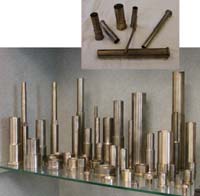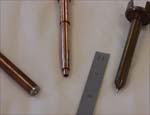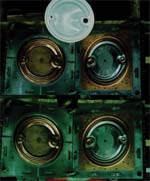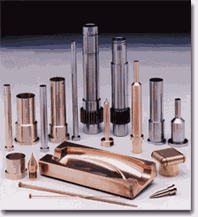|
|
|

...World Wide Distributor of Beryllium-Free
Copper Alloys...
Manufacturer of Standard &
Custom Components

Site
Updated Often! To ensure proper viewing please Refresh page &
MAKE SURE YOUR BROWSER
IS SET TO UPDATE AT EACH VISIT

|
Design Criteria for Using Copper
Alloys in Molds
The extent of copper alloy use, the success of its application and the life of the
components are determined by the selected alloy in combination with the design of the
application.
By Cliff Moberg |
| The origin of mold design and moldmaking in the
U.S. is traceable to metal stamping die makers, rubber moldmakers and die cast die makers.
Early pioneers in plastics went to these established tradesmen because of their history in
designing and building tools for production, the preciseness of workmanship as well as
familiarity with 2-D and 3-D shapes. Unfortunately the majority of molds designed and
built today have not evolved much since those very early practices. Most designs fail to
truly consider the dynamics of the molding process. Because of the lack of willingness and
insight to change, tool steels are the most widely used and accepted materials for cores
and cavities. While tool steels do have a place in designs, there is a tendency to overuse
tool steel, which in effect sacrifices mold performance. Oftentimes the only design and
build criteria given is to construct a device just adequate enough to make an acceptable
plastic part. Production efficiency is not always a factor of importance. Long gone in
profitable molding operations are molding machines with magnetic relays, mechanical
timers, manually set limit switches that controlled machine motion and would only do one
action at a time. Combine the molding machines available today with plastic resins and
support equipment, and it is obvious that the mold is now the weakest link in the profit
chain. The mold is all too often the limiting factor in the molding process.
It is hard to believe that there are a significant number of molders, mold designers
and builders that continue to follow stagnant or outdated designs, for some very
irrational reasons. It is only in the last few years that processors are finally placing
expectations on mold builders to meet minimum or guaranteed mold cycle times. Where do
mold designers and moldmakers look for answers? |
 Ejector
sleeves in various Beryllium-free bronze alloys used to replace tool steel in high-volume
mold applications. Photos courtesy of |
Copper Alloys
When mold designers, moldmakers or plastics processors are conceptualizing, initiating or
committing to paper a mold design, there is little if any integration of copper alloys as
major plastic forming steel. The absence of copper alloys in a mold is the result of
ignorance, fear, misconception, some prior bad experience or misinformation.The
presence of copper alloys in a mold and the extent of that usage merely means that at
least someone in the design chain had some awareness and understanding of the benefits of
using those materials. The extent of copper alloy use, the success of its application as
well as the life of those components will ultimately be determined by the selected alloy
in combination with the design of the application.
High Conductivity Copper Alloys
In reference to high conductivity copper alloys, there needs to be clarification
of products that are best suited for molding applications. The use of the term high
conductivity here references products with at least 60 BTUs/sqft/ft/°F of thermal
conductivity. Copper alloys with lower conductivity do have applications in molds, but not
as plastic forming surfaces. Relative to conductivity, there are hundreds of copper alloys
produced throughout the world. It is important to recognize that among the various copper
alloys, thermal as well as the relative electrical conductivity, can vary to extremes
depending on the product designation. This variance also can be prevalent with the same
alloy designation coming from different suppliers/producers. This is because there are
subtle variances in the equipment that manufacturers use. There also can be variances in
the quality of feedstock used to make the alloys. The best alloys available for thermal
conductivity as well as for overall performance in molds are all virgin materials for
feedstock—no back scrap or reprocessed elements in the chemistry. |
|
Primary Design
Considerations
Testing at Western Michigan University concluded that 90 percent of the heat removed from
a molded part occurs from contact of the plastic resin with the core surfaces of the mold.
This of course means that the cavity surfaces have little to no influence in heat removal.
This is because as the part shrinks—which occurs fairly early in the molding
cycle—the parts lose contact with the cavity surface, creating an insulating air gap.
At best there can be no more than 25 percent of the heat removed from the resin by the
cavity surfaces. Therefore, high conductivity alloys or overly complex cooling channels on
the cavity side of the mold will provide the least cooling benefit. So a cores only
approach is recommended with copper alloys. The point is, people that have experience
using copper alloys in molds know the facts and have seen the overall benefits, will
rarely design a mold without using copper alloys to one degree or another. |
Failure in Molding Applications In the molding and mold
building business, there are no shortages of failures and problems, regardless of the
players and whether the material used for components is tool steel or a copper alloy.
Generally when copper alloy components fail, it is commonplace for those involved to point
at the copper alloy as the root cause of the problem. The statement “If it were tool
steel, this would not have happened,” is all too common. This statement also is
usually the furthest from the truth.
Proper analysis of the failure is most often the exception, rather than the rule. Even
when you believe the right people are involved in analyzing the failure. Do you have the
right people looking at the problem or are the responses self-serving? Do you get the
right answers, or just responses? Rather than seek out the right answer and a solution
that yields the best outcome, there is misunderstanding, misinformation and rhetoric about
the incident and the direction forward. If this is the case, there is little opportunity
for progress and ultimate ongoing success. |
|
Cycle Limiting Factors
Molding surfaces are not always the cycle limiting factors. In some molds the cycle time
can be limited by the material delivery system. This type of cycle limiting condition is
present in molds where the molded part(s) have solidified enough to eject. And where some
portion of the material delivery system—such as the main runner, sub runner or
sprue—is too soft and pliable to open the mold and ejects, without causing some
secondary problem. These are cases in which copper alloys should be considered for
insertion as the runner insert, sprue bushing or manifold plate as well as other hot
runner components. |
 Examples where stainless steel was welded in areas for added
hardness, by design. |
Benefits
Typically the basic use of high conductivity copper alloys as molding surfaces that would
normally be identified as difficult to cool, result in cycle time improvements of
20 to 30 percent. By following what would be considered by most moldmakers, aggressive
design concepts combined with adequate molding machining capabilities, cycle times can be
reduced by 50 percent and more. With the arrival of some new copper alloys in the
market place in the last three years, combined with experience and refinements in
design/utilization concepts, copper alloys are finally entering a new era of acceptance. |
|
Hardness
This is one of the more misunderstood and misrepresented phenomenon with copper alloys.
Most copper alloys offering high thermal conductivity, high mechanical strength and
hardness are from a family of metals considered to be precipitation hardening
materials. Another term used to define this heat treatment is an aging process.
The specific aging processes are based on the copper alloy chemistry, which when aged in a
controlled environment, determines the alloy hardness. In addition to affecting the
chemical structure, the aging process also yields controlled levels of thermal and
electrical conductivity. Precipitation hardening is done by heating an alloy to a specific
temperature, then holding at that temperature for a predetermined period of time, then
air-cooled. For stability reasons aging is done only after a solution annealing process.
This means that the alloy properties are changed when exposed to time and temperature
while in use—by welding, surface treatments or some incident that heats the component
to a temperature above the original aging temperature. Exposure to time and relative
temperatures over the original aging temperature for a specific alloy can either increase
or decrease the properties of the alloy. An occurrence called over aging can
seriously affect the short- and long-term performance of copper alloy mold components. |
| Over aging also can soften materials to surprisingly low levels, where the components
will fail because of lack of expected hardness. Or, over aging can reduce elongation and
ductility to the point where the mold component fractures because it is too brittle for an
application. Copper alloys, like tool steels, provide the most desirable performance
characteristics at optimum hardness rather than ultimate hardness.
Some alloy manufacturers provide products at the ultimate hardness in efforts to entice
buyers with the highest hardness products. While other manufacturers provide
products at the optimum, which in effect allows for the slight increase in hardness and
lower ductility as a result of continued aging. Providing products at the ultimate
hardness is a disservice to users because the ductility of the product is
low—generally 3 percent elongation or less, which when used in molding and exposed to
ongoing time and temperature, exhibit even less ductility and eventually fail due to
fracture.
If someone told you that two years after running a mold 24/7, your mold components made
of a copper alloy—chosen because it was 38-40 Rockwell “C”—would start
fracturing like glass, would you believe them? Those that don’t soon find out that
the copper alloys at 30 Rockwell “C” are the superior choice and will yield the
longest lasting components. In other words, buyer beware of copper alloys offered at or
near 40 Rockwell “C”. |
Grain Structure
In the production of copper alloys there are either cast or wrought product forms. This
refers to methods used to produce a final product, which is then machined to the desired
shape by the end user. Cast products can be gravity cast, pressure cast or continuous
cast. Cast materials typically exhibit characteristics unique to the process, with some
similarity to wrought products. Wrought products on the other hand are hot worked
to shape/form yielding performance characteristics that differ vastly from a cast product.
Typically, cast products have lower ductility, are notch sensitive and can be porous.
Wrought products have the most uniform grain structure and grain size, have a balanced
ductility-to-hardness ratio and show much better machining characteristics. Wrought copper
alloys make the best mold core making material. Cast alloys are well suited for wear
plates, gibs and the like. |
 Core and cavity mold halves for a 55-gallon drum lid using
Beryllium-free copper alloys. |
|
Significance of Machining Equipment
It is no secret that copper alloys are difficult to machine by conventional EDM because of
the thermal and electrical conductivity. What makes it a great mold core material, makes
it a lousy EDM workpiece. The high conductivity characteristics defeat the EDM metal
removal process. Most EDM tool manufacturers and electrode manufacturers seem to take the
position that there is no real way to improve. On the other hand, there are EDM tools
being made with linear motion systems and control technology that appear to address the
slow metal removal rates, high electrode wear rates and the potential for DC arcing. Check
out EDM dealers or EDM houses that have linear drive axis machines. |
Abrasive Resins
There always is concern for wear of molding surfaces when abrasive resins are being used.
Abrasive resins are most damaging at the area opposite the gate and on low or no draft
surfaces. The area opposite the gate is exposed to tremendous velocities and volumes of
resin, so replaceable hardened wear inserts should be part of the mold design. As far as
no or low draft wall surfaces, filled resins are most abrasive when the resin is
solidified upon part ejection. Generous draft angles on part walls will reduce or
eliminate wear caused by part ejection. Hot Runner Gate Drops
When a mold design requires that a heated gate drop be integrated into a molding detail,
there must be a bushing designed around the drop. The bushing must be made using a low
conductivity material such as stainless steel. Also, relieve the diameter of the bushing
at non-critical fit points to further insulate the drop. If this bushing design is not
utilized, the heater element in the drop will work to overcome the cooling effect of the
molding detail, which in effect, will actually cause the plastic part to cool slower and
the cycle time to be longer.
Coatings and Platings
Coatings and plating of various sorts have proven to be a cost-effective way to further
enhance the already impressive performance of copper alloys in mold applications. It is
important to note that coatings and platings do not affect the heat removal
characteristics. It is significant to note though, that there are certain copper alloys
that have aging temperatures in the 600oF range. Alloys with low aging temperatures are
unintentionally softened during application of Titanium Nitride. It is important to know
the coating, know the application temperatures of the coating and know the final aging
temperatures of the alloys to preserve expensive mold components. |
Designing Costs Out of Molds Do you want cheap? If that
is the criteria established at the onset of a mold or molding project, the results are
going to be questionable, even downright bad. The fact is there are limited ways for molds
to become cheap or competitively priced. Elimination of steps in machining processes such
as hard machining has become the norm in moldmaking today—in addition to unattended
machine operations and subcontracting work to supply partners using specialized machines,
talents or automated facilities that a primary moldmaker may not have or in which to
invest. This is a huge cost savings.
High conductivity copper alloys are all offered at what is described as the usable
hardness of the product, so hard machining is a given. The next criteria of cost reduction
then becomes using designs that do not over use more expensive materials, which copper
alloys tend to be when compared to tool steels. Oftentimes, rather than making the entire
core using a copper alloy, inserting portions of the mold core with high conductivity
alloys will accomplish the same cycle reduction, but at a much lower net cost. Designing
costs out also is why we forget about making the cavity out of copper alloys. The heat
removal there is insignificant, so the return on investment or extra cost makes no
practical sense. |
|
The Material Supplier Relationship
The copper alloy materials supplier must be measured and held to the same standards as you
would hold a moldmaker and mold designer. If you are expecting to use a material source
for design guidelines/recommendations, troubleshooting and building ongoing relations, it
is important to select a supplier that is experienced with applying their products in mold
applications. Be selective. Ask for and check references.Paying the Price to Advance
The only way to fend off decline as well as extinction is to pursue technical advantages
that other companies and countries overlook, cannot afford or are unwilling or unable to
embrace. There is a long list of companies and individuals who have failed or have
downsized because of decisions not to embrace improvements in technology. Copper alloy use
in mold design and construction is one of the technical avenues that is still in the early
stages of use worldwide. It is clear that there are opportunities and rewards for those
willing to pay the price to advance |
|
SITE INDEX
|
Disclaimer
While the information contained is deemed reliable, no warranties are expressed or
implied. For specific information regarding an application please call 1-800-272-3031 or
e-mail us at sales@moldstar.com
|
|
Copyright © 1998-2014 by Performance Alloys &
Services, Inc
Web site hosted by APLUS Hosting
All Rights Reserved.
|
|





